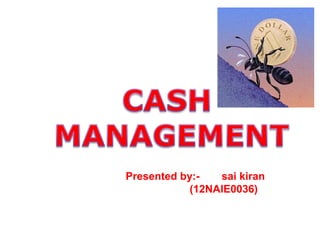
Managing cash flows and liquidity
- 2. In narrow sense: currency and generally accepted equivalents of cash like cheques, drafts etc. In broad sense: includes near-cash assets, such as marketable securities and time deposits in banks. They can be readily sold and converted into cash. Can serve as a reserve pool of liquidity. Also provide short term investment outlet for excess cash.
- 3. Cash management is concerned with the managing of: cash flows into and out of the firm, cash flows within the firm, and cash balances held by the firm at a point of time by financing deficit or investing surplus cash
- 4. Cash planning Managing the cash flows Optimum cash level Investing surplus cash
- 5. Transaction motive Precautionary motive Speculative motive compensating motive
- 6. Holding of cash to meet routine cash requirements to finance the transactions which a firm carries on in the ordinary course of business. Cash is held to pay for goods or services. It is useful for conducting our everyday transactions or purchases.
- 7. • • The cash balances held in reserve for random and unforeseen fluctuations in cash flows. A cushion to meet unexpected contingencies. Floods, strikes and failure of imp customers – Unexpected slowdown in collection of accounts receivable – Sharp increase in cost of raw materials – Cancellation of some order of goods – • Defensive in nature
- 8. Is a motive for holding cash/near-cash to quickly take advantage of opportunities typically outside the normal course of business. Positive and aggressive approach Helps to take advantage of: An opportunity to purchase raw materials at reduced price Make purchase at favorable prices Delay purchase on anticipation of decline in prices Buying securities when interest rate is expected to decline
- 9. Is a motive for holding cash/near-cash to compensate banks for providing certain services or loans. Clients are supposed to maintain a minimum balance of cash at the bank which they cannot use themselves.
- 10. • Meeting payments schedule – – – – – – – • It prevents insolvency relationship with bank is not constrained Helps in fostering good relationships Cash discount can be availed Strong credit rating Take advantage of business opportunities Can meet unanticipated cash expenditure with a minimum of strain. Minimizing funds committed to cash balances High level of cash: large funds remain idle – Low level of cash: failure to meet payment schedule –
- 11. Accelerating Cash Collections Controlling Disbursements
- 12. 1. Decentralised Collections number of collection centres Collection centres will collect cheques from customers and deposit in their local bank accounts They will deposit the funds to a central bank
- 13. 2. Lock-box System Collection centers are established considering the customer locations and volume of remittances At each centre the firm hires a post office box Remittances are directly picked from the bank whom the firm gives the authority Advantages of lock-box system are cheques are deposited immediately upon receipt of remittances Eliminates the period between the time cheques are received by the firm and the time they are deposited in the bank for collection
- 14. It means delay the payments as much as possible. Can help the firm in conserving cash and reducing the financial requirements. Disbursement or Payment Float
- 15. How quickly and cheaply a organization can raise cash when needed. How accurately managers can predict cash requirements. Cash budget helps in this . How much precautionary cash the managers need for emergencies.
- 16. • Availability of (short-term) investment opportunities – e.g. money market funds, CDs, commercial paper • Expected return on investment opportunities. – e.g. If expected returns are high, organizations should be quick to invest excess cash • Transaction cost of withdrawing cash and making an investment • Demand for Cash for daily transactions
